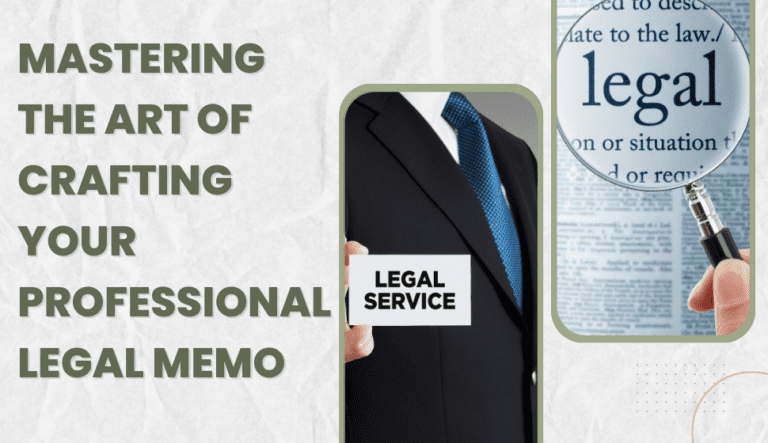Introduction
A legal memo, also known as a legal memorandum, is a document that summarises the legal issues in a case and offers an attorney’s analysis of the legal position. It can be difficult to write your first professional legal memo, but with the correct format and direction, you can produce a clear and succinct document that clearly explains your analysis and findings. In this guide, we will walk you through the process of a step-by-step lesson on how to write a professional legal note in this blog, complete with guidelines, examples, and templates.
Understanding the Legal Memo Format
Before we dive into the details of writing a legal memo, let’s first understand its format. A legal memo typically comprises six sections, with the following information:
- Heading or caption: This section includes the recipient (To _______), the author (From ____), the assignment submission date (typically in MMMM DD YYYY format), and the subject of the memo (Re: __________).
- Question Presented: This section presents the legal issue that you have been asked by your client and/or partner to answer. It should be a concise and clear statement of the issue.
- Brief Answer: You should wrap up your legal analysis and answer the posed question in this section. There shouldn’t be any citations in the conclusion.
- Statement of Facts: The pertinent facts of the case are briefly outlined in this section. Make careful to only enter the information that is required for your analysis.
- Discussion: The Discussion section is where your legal memo really shines. You will conduct an analysis of the legal concerns, apply the pertinent legal standards, and express any objections or further interpretations.
- Conclusion: You should restate your primary ideas in the conclusion section and give a clear and succinct summary of your study and findings. Again, there should be no citations in this part.
Writing Your First Professional Legal Memo
Now that we have a clear understanding of the legal memo format, let’s dive into the process of writing your first professional legal memo.
- Gather the necessary information: Make sure you have all the necessary information before you begin writing, including the assignment’s specifics, research resources, and any prior legal memos on related subjects.
- Create a memo template: Make a template for future memos using the legal memo format that was previously mentioned. In the long run, this will help standardize your document formats and save you time.
- Write the heading: Write the header at the top of your message, which should include the receiver, author, date, and memo subject. The reader should be able to swiftly understand the memo’s purpose thanks to this information’s clarity and succinctness.
- Craft a compelling introduction: Give a brief summary of the legal concerns and the memo’s goal in the introduction. This will set the reader up for success and aid in their orientation to the rest of the text.
- Present the Question Presented: Clearly state the legal question you are being asked to address in this part. Concentrate on the memo’s core argument and be succinct and detailed.
- Provide a brief answer: Write a brief explanation of your legal analysis and conclusion to the asked question in the box titled “Brief Answer.” Be brief once more, and exclude any citations.
- State the facts: Give a succinct rundown of the pertinent case facts in the Statement of Facts section. Make careful to only enter the information that is required for your analysis.
- Discuss the legal issues: You will analyze the legal concerns, apply the pertinent law, and discuss any oppositional viewpoints or alternate interpretations in the Discussion section. Write in a clear, straightforward manner and cite the proper legal authorities to back up your claims.
- Summarize your analysis and conclusions: Reiterate your primary points in the conclusion section and give a succinct overview of your study and findings. Once more, omit all citations.
- Proofread and edit: Check your memo for mistakes and inconsistencies before submitting it. To make your note look polished and professional, pay close attention to the grammar, punctuation, and formatting.

Conclusion
It can be difficult to write your first professional legal memo, but with the correct form and direction, you can produce a document that clearly expresses your analysis and findings. Use a note template to standardize your document types and save time. To increase your general efficiency and effectiveness when producing legal memoranda, work on your legal writing abilities. You will be well on your way to mastering the art of drafting expert legal memos if you adhere to the procedures mentioned in this blog and use the accompanying memo template.
Remember, a well-crafted legal memo can be a powerful tool in the arsenal of any legal professional. So, whether you’re a law student or a seasoned attorney, honing your memo-writing skills is a worthwhile endeavor.
For further guidance and law memo examples, don’t hesitate to reach out to our team at Assignment Unlocked. We’re here to assist you on your journey to becoming a proficient legal writer.
Ready to enhance your legal memo-writing skills? Explore our comprehensive collection of law memo examples and templates at Assignment Unlocked. Elevate your legal communication game today!





